Religion in WWI Lesson 2
Chris Knepp
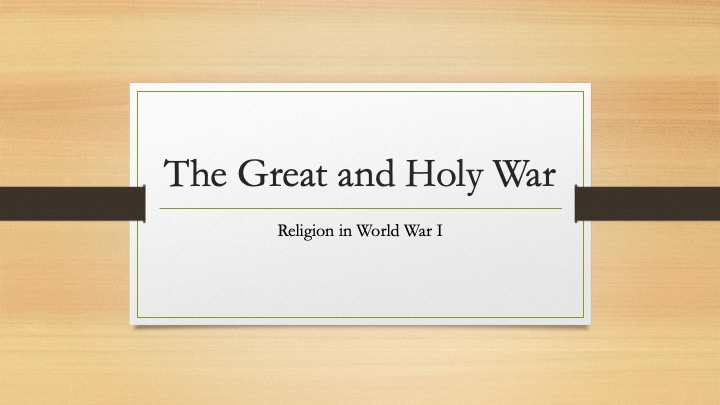
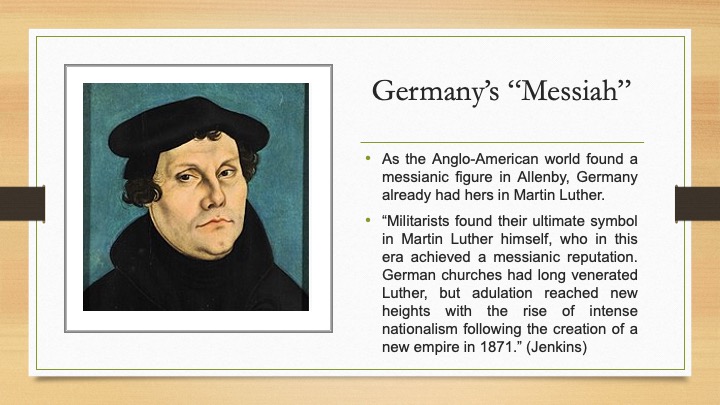
Germany’s “Messiah”
As the Anglo-American world found a messianic figure in Allenby, Germany already had hers in Martin Luther.
“Militarists found their ultimate symbol in Martin Luther himself, who in this era achieved a messianic reputation. German churches had long venerated Luther, but adulation reached new heights with the rise of intense nationalism following the creation of a new empire in 1871.” (Jenkins)
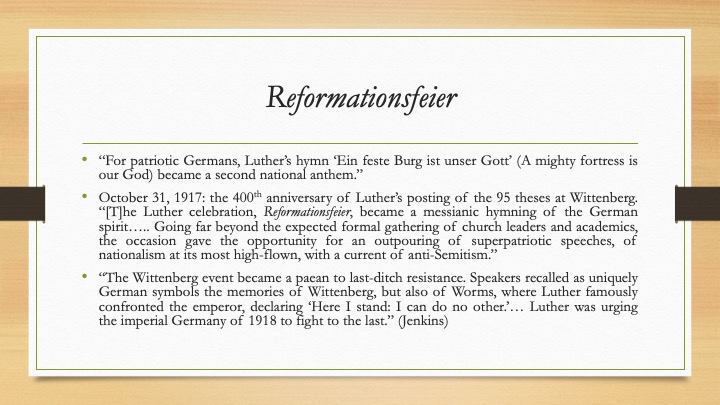
Reformationsfeier
“For patriotic Germans, Luther’s hymn ‘Ein feste Burg ist unser Gott’ (A mighty fortress is our God) became a second national anthem.”
October 31, 1917: the 400th anniversary of Luther’s posting of the 95 theses at Wittenberg. “[T]he Luther celebration, Reformationsfeier, became a messianic hymning of the German spirit….. Going far beyond the expected formal gathering of church leaders and academics, the occasion gave the opportunity for an outpouring of superpatriotic speeches, of nationalism at its most high-flown, with a current of anti-Semitism.”
“The Wittenberg event became a paean to last-ditch resistance. Speakers recalled as uniquely German symbols the memories of Wittenberg, but also of Worms, where Luther famously confronted the emperor, declaring ‘Here I stand: I can do no other.’… Luther was urging the imperial Germany of 1918 to fight to the last.” (Jenkins)
Religion In WWI
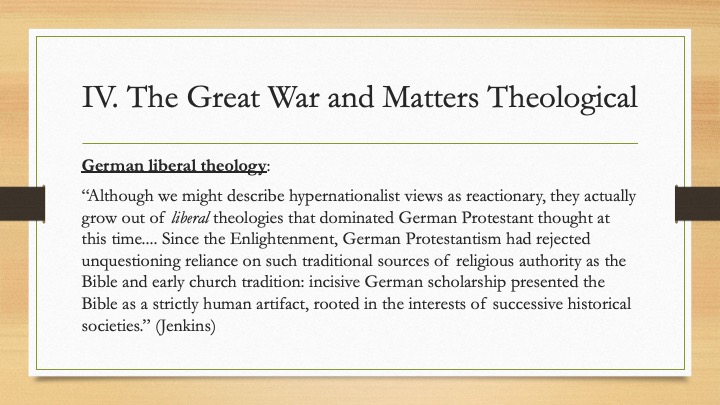
IV. The Great War and Matters Theological
German liberal theology:
“Although we might describe hypernationalist views as reactionary, they actually grow out of liberal theologies that dominated German Protestant thought at this time.... Since the Enlightenment, German Protestantism had rejected unquestioning reliance on such traditional sources of religious authority as the Bible and early church tradition: incisive German scholarship presented the Bible as a strictly human artifact, rooted in the interests of successive historical societies.” (Jenkins)
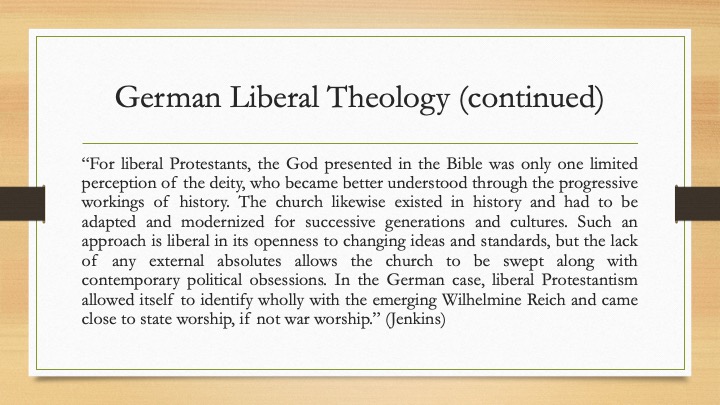
German Liberal Theology (continued)
“For liberal Protestants, the God presented in the Bible was only one limited perception of the deity, who became better understood through the progressive workings of history. The church likewise existed in history and had to be adapted and modernized for successive generations and cultures. Such an approach is liberal in its openness to changing ideas and standards, but the lack of any external absolutes allows the church to be swept along with contemporary political obsessions. In the German case, liberal Protestantism allowed itself to identify wholly with the emerging Wilhelmine Reich and came close to state worship, if not war worship.” (Jenkins)
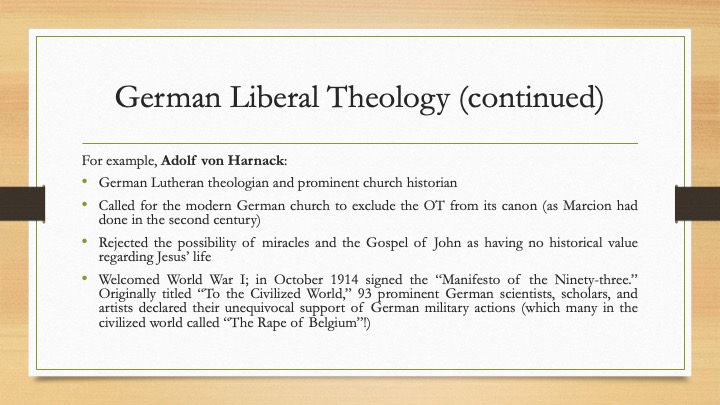
German Liberal Theology (continued)
For example, Adolf von Harnack:
German Lutheran theologian and prominent church historian
Called for the modern German church to exclude the OT from its canon (as Marcion had done in the second century)
Rejected the possibility of miracles and the Gospel of John as having no historical value regarding Jesus’ life
Welcomed World War I; in October 1914 signed the “Manifesto of the Ninety-three.” Originally titled “To the Civilized World,” 93 prominent German scientists, scholars, and artists declared their unequivocal support of German military actions (which many in the civilized world called “The Rape of Belgium”!)
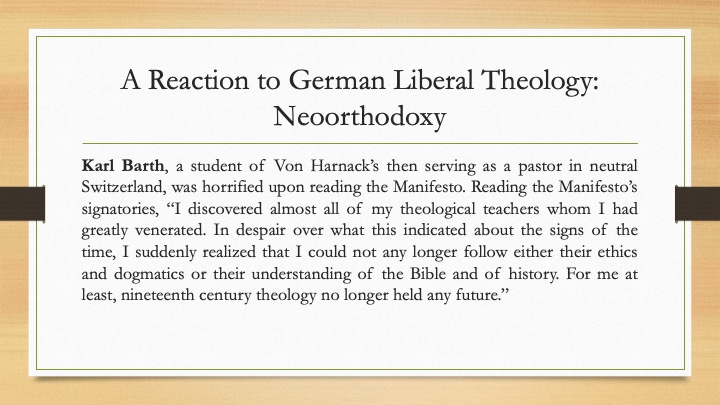
A Reaction to German Liberal Theology: Neoorthodoxy
Karl Barth, a student of Von Harnack’s then serving as a pastor in neutral Switzerland, was horrified upon reading the Manifesto. Reading the Manifesto’s signatories, “I discovered almost all of my theological teachers whom I had greatly venerated. In despair over what this indicated about the signs of the time, I suddenly realized that I could not any longer follow either their ethics and dogmatics or their understanding of the Bible and of history. For me at least, nineteenth century theology no longer held any future.”
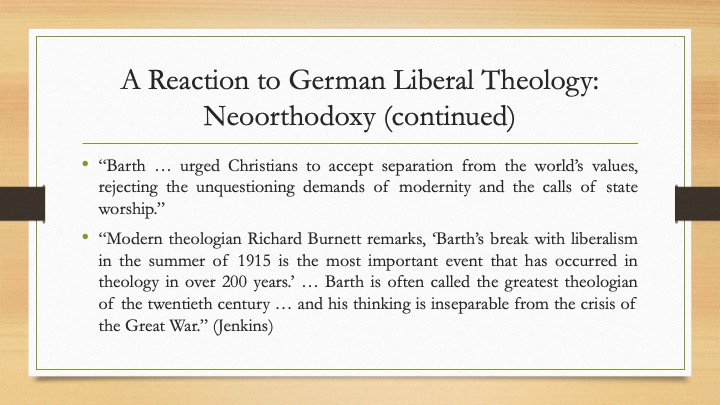
A Reaction to German Liberal Theology: Neoorthodoxy (continued)
“Barth … urged Christians to accept separation from the world’s values, rejecting the unquestioning demands of modernity and the calls of state worship.”
“Modern theologian Richard Burnett remarks, ‘Barth’s break with liberalism in the summer of 1915 is the most important event that has occurred in theology in over 200 years.’ … Barth is often called the greatest theologian of the twentieth century … and his thinking is inseparable from the crisis of the Great War.” (Jenkins)
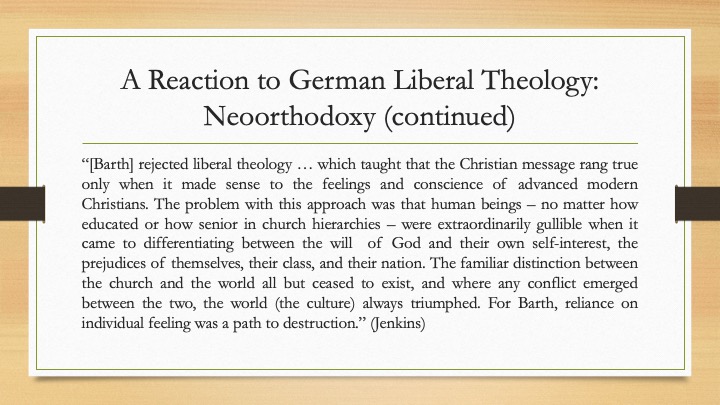
A Reaction to German Liberal Theology: Neoorthodoxy (continued)
“[Barth] rejected liberal theology … which taught that the Christian message rang true only when it made sense to the feelings and conscience of advanced modern Christians. The problem with this approach was that human beings – no matter how educated or how senior in church hierarchies – were extraordinarily gullible when it came to differentiating between the will of God and their own self-interest, the prejudices of themselves, their class, and their nation. The familiar distinction between the church and the world all but ceased to exist, and where any conflict emerged between the two, the world (the culture) always triumphed. For Barth, reliance on individual feeling was a path to destruction.” (Jenkins)
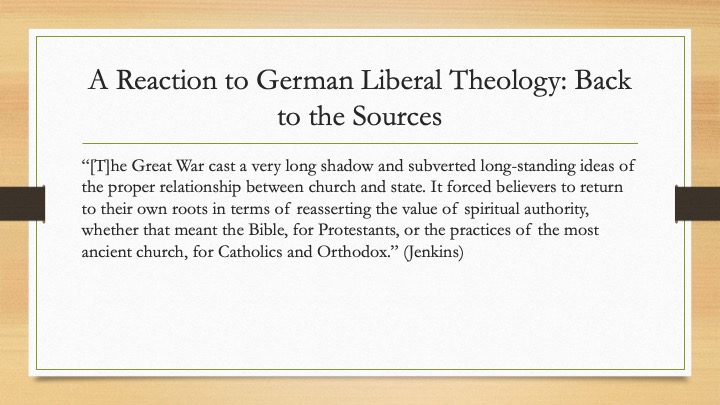
A Reaction to German Liberal Theology: Back to the Sources
“[T]he Great War cast a very long shadow and subverted long-standing ideas of the proper relationship between church and state. It forced believers to return to their own roots in terms of reasserting the value of spiritual authority, whether that meant the Bible, for Protestants, or the practices of the most ancient church, for Catholics and Orthodox.” (Jenkins)
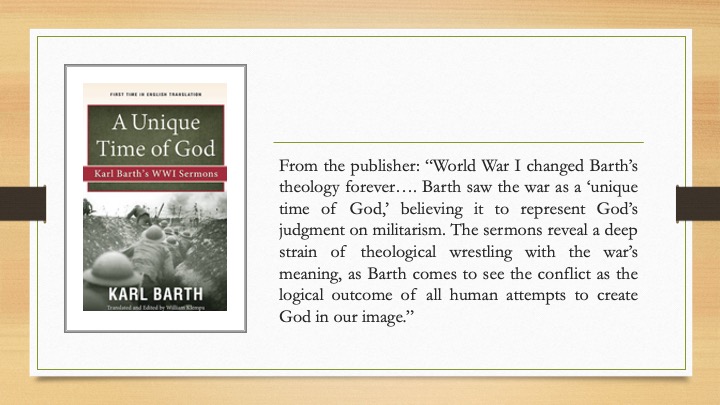
For those who are interested….
From the publisher: “World War I changed Barth’s theology forever…. Barth saw the war as a ‘unique time of God,’ believing it to represent God’s judgment on militarism. The sermons reveal a deep strain of theological wrestling with the war’s meaning, as Barth comes to see the conflict as the logical outcome of all human attempts to create God in our image.”
Religion In WWI
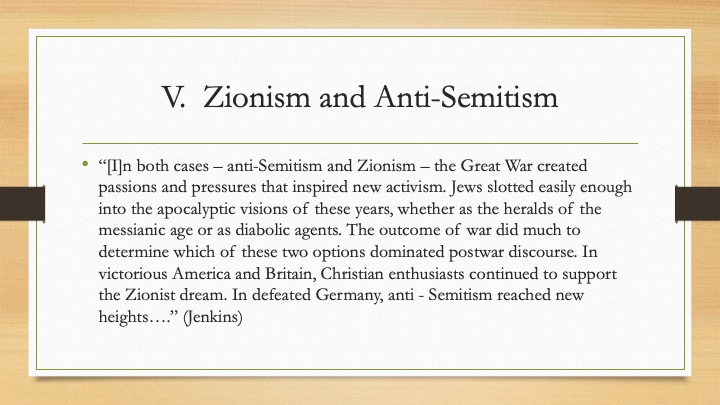
V. Zionism and Anti-Semitism
“[I]n both cases – anti-Semitism and Zionism – the Great War created passions and pressures that inspired new activism. Jews slotted easily enough into the apocalyptic visions of these years, whether as the heralds of the messianic age or as diabolic agents. The outcome of war did much to determine which of these two options dominated postwar discourse. In victorious America and Britain, Christian enthusiasts continued to support the Zionist dream. In defeated Germany, anti - Semitism reached new heights….” (Jenkins)
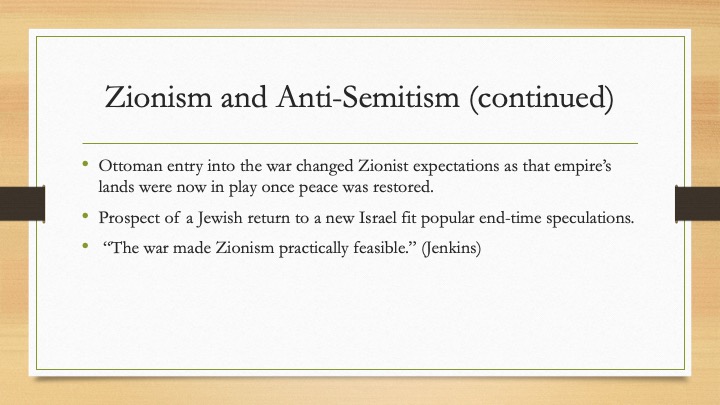
Zionism and Anti-Semitism (continued)
Ottoman entry into the war changed Zionist expectations as that empire’s lands were now in play once peace was restored.
Prospect of a Jewish return to a new Israel fit popular end-time speculations.
“The war made Zionism practically feasible.” (Jenkins)
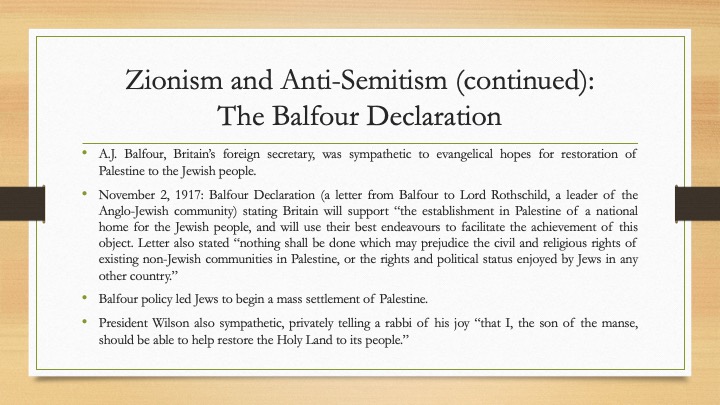
Zionism and Anti-Semitism (continued): The Balfour Declaration
A.J. Balfour, Britain’s foreign secretary, was sympathetic to evangelical hopes for restoration of Palestine to the Jewish people.
November 2, 1917: Balfour Declaration (a letter from Balfour to Lord Rothschild, a leader of the Anglo-Jewish community) stating Britain will support “the establishment in Palestine of a national home for the Jewish people, and will use their best endeavours to facilitate the achievement of this object. Letter also stated “nothing shall be done which may prejudice the civil and religious rights of existing non-Jewish communities in Palestine, or the rights and political status enjoyed by Jews in any other country.”
Balfour policy led Jews to begin a mass settlement of Palestine.
President Wilson also sympathetic, privately telling a rabbi of his joy “that I, the son of the manse, should be able to help restore the Holy Land to its people.”
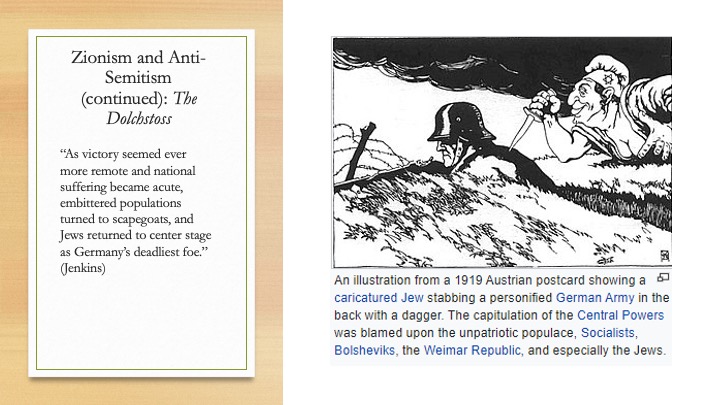
Zionism and Anti-Semitism (continued): The Dolchstoss
“As victory seemed ever more remote and national suffering became acute, embittered populations turned to scapegoats, and Jews returned to center stage as Germany’s deadliest foe.” (Jenkins)
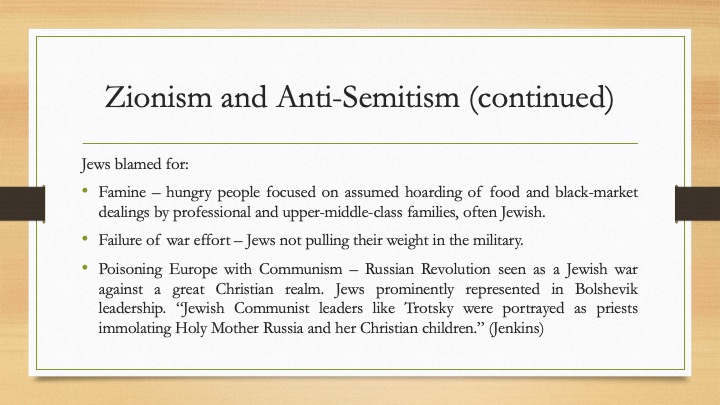
Zionism and Anti-Semitism (continued)
Jews blamed for:
Famine – hungry people focused on assumed hoarding of food and black-market dealings by professional and upper-middle-class families, often Jewish.
Failure of war effort – Jews not pulling their weight in the military.
Poisoning Europe with Communism – Russian Revolution seen as a Jewish war against a great Christian realm. Jews prominently represented in Bolshevik leadership. “Jewish Communist leaders like Trotsky were portrayed as priests immolating Holy Mother Russia and her Christian children.” (Jenkins)
Religion In WWI
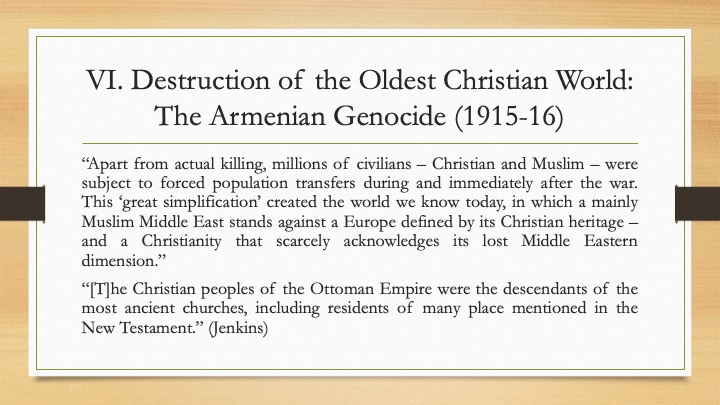
VI. Destruction of the Oldest Christian World: The Armenian Genocide (1915-16)
“Apart from actual killing, millions of civilians – Christian and Muslim – were subject to forced population transfers during and immediately after the war. This ‘great simplification’ created the world we know today, in which a mainly Muslim Middle East stands against a Europe defined by its Christian heritage – and a Christianity that scarcely acknowledges its lost Middle Eastern dimension.”
“[T]he Christian peoples of the Ottoman Empire were the descendants of the most ancient churches, including residents of many place mentioned in the New Testament.” (Jenkins)
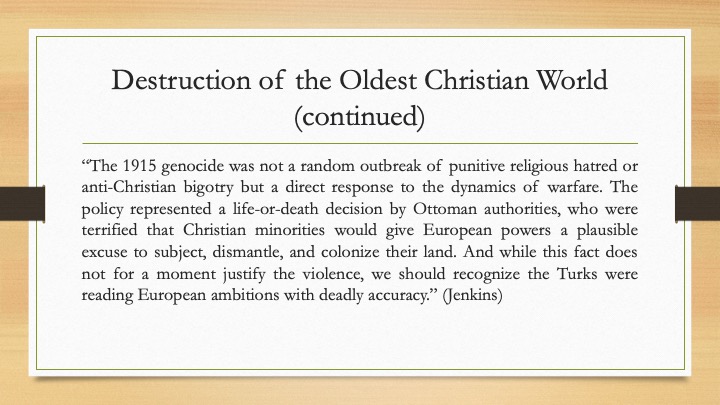
Destruction of the Oldest Christian World (continued)
“The 1915 genocide was not a random outbreak of punitive religious hatred or anti-Christian bigotry but a direct response to the dynamics of warfare. The policy represented a life-or-death decision by Ottoman authorities, who were terrified that Christian minorities would give European powers a plausible excuse to subject, dismantle, and colonize their land. And while this fact does not for a moment justify the violence, we should recognize the Turks were reading European ambitions with deadly accuracy.” (Jenkins)
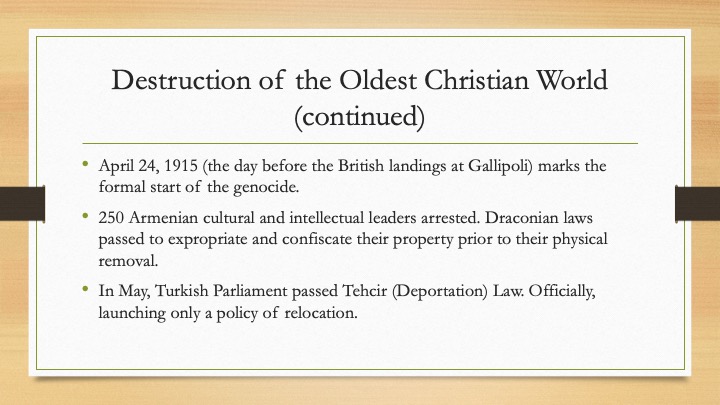
Destruction of the Oldest Christian World (continued)
April 24, 1915 (the day before the British landings at Gallipoli) marks the formal start of the genocide.
250 Armenian cultural and intellectual leaders arrested. Draconian laws passed to expropriate and confiscate their property prior to their physical removal.
In May, Turkish Parliament passed Tehcir (Deportation) Law. Officially, launching only a policy of relocation.
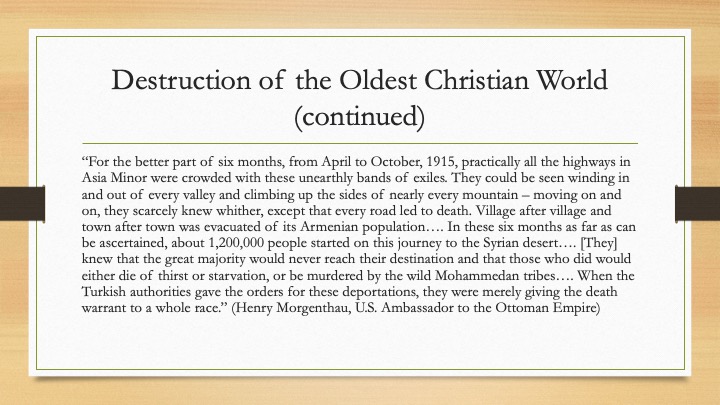
Destruction of the Oldest Christian World (continued)
“For the better part of six months, from April to October, 1915, practically all the highways in Asia Minor were crowded with these unearthly bands of exiles. They could be seen winding in and out of every valley and climbing up the sides of nearly every mountain – moving on and on, they scarcely knew whither, except that every road led to death. Village after village and town after town was evacuated of its Armenian population…. In these six months as far as can be ascertained, about 1,200,000 people started on this journey to the Syrian desert…. [They] knew that the great majority would never reach their destination and that those who did would either die of thirst or starvation, or be murdered by the wild Mohammedan tribes…. When the Turkish authorities gave the orders for these deportations, they were merely giving the death warrant to a whole race.” (Henry Morgenthau, U.S. Ambassador to the Ottoman Empire)
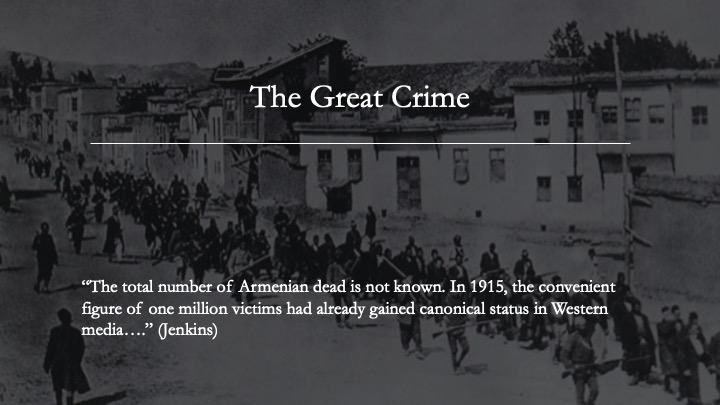
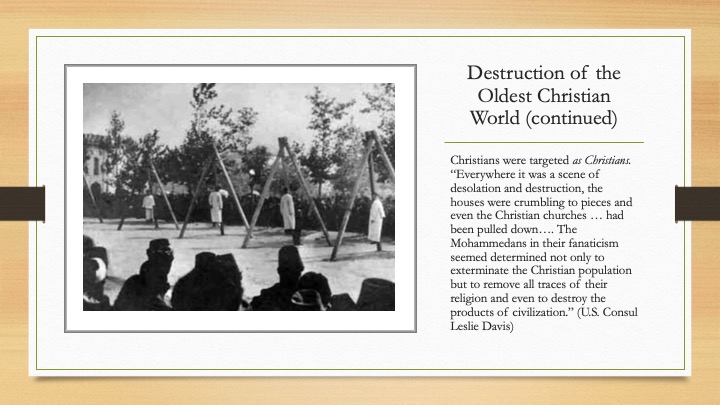
Destruction of the Oldest Christian World (continued)
Christians were targeted as Christians. “Everywhere it was a scene of desolation and destruction, the houses were crumbling to pieces and even the Christian churches … had been pulled down…. The Mohammedans in their fanaticism seemed determined not only to exterminate the Christian population but to remove all traces of their religion and even to destroy the products of civilization.” (U.S. Consul Leslie Davis)
Religion In WWI
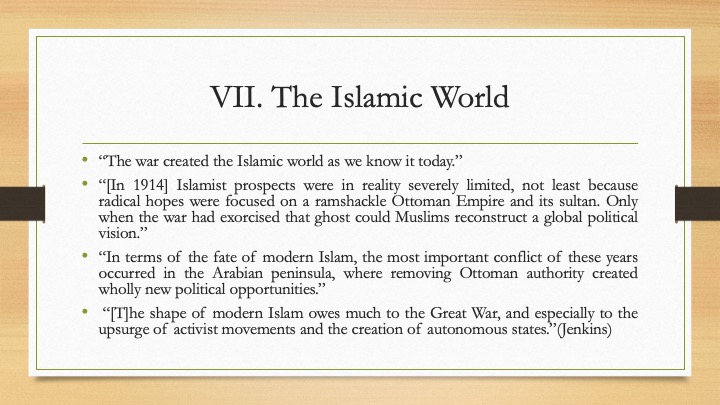
VII. The Islamic World
“The war created the Islamic world as we know it today.”
“[In 1914] Islamist prospects were in reality severely limited, not least because radical hopes were focused on a ramshackle Ottoman Empire and its sultan. Only when the war had exorcised that ghost could Muslims reconstruct a global political vision.”
“In terms of the fate of modern Islam, the most important conflict of these years occurred in the Arabian peninsula, where removing Ottoman authority created wholly new political opportunities.”
“[T]he shape of modern Islam owes much to the Great War, and especially to the upsurge of activist movements and the creation of autonomous states.”(Jenkins)
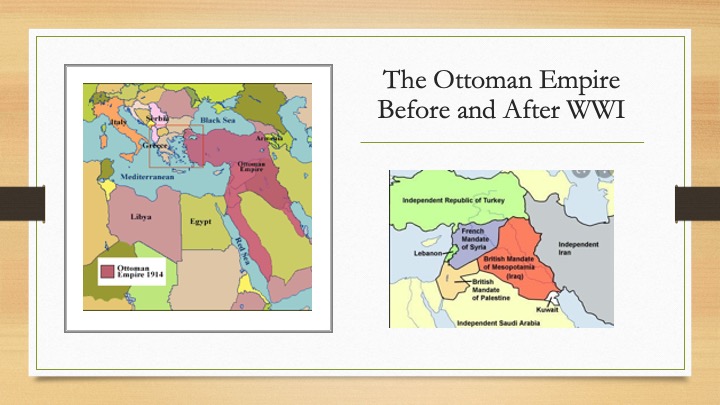
Religion In WWI
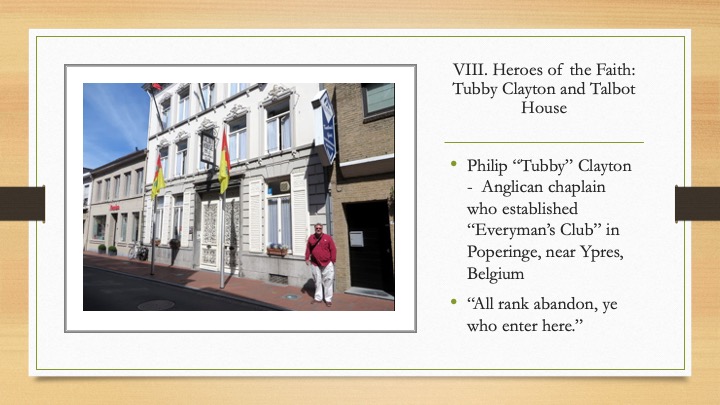
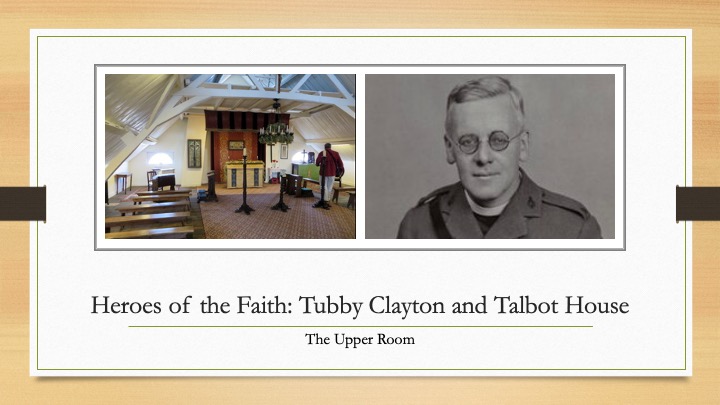
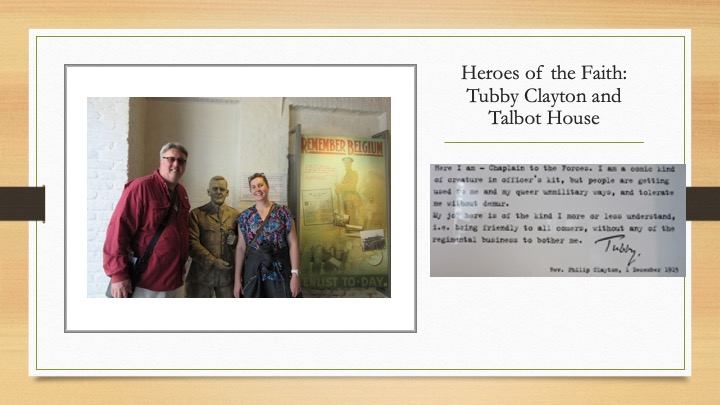
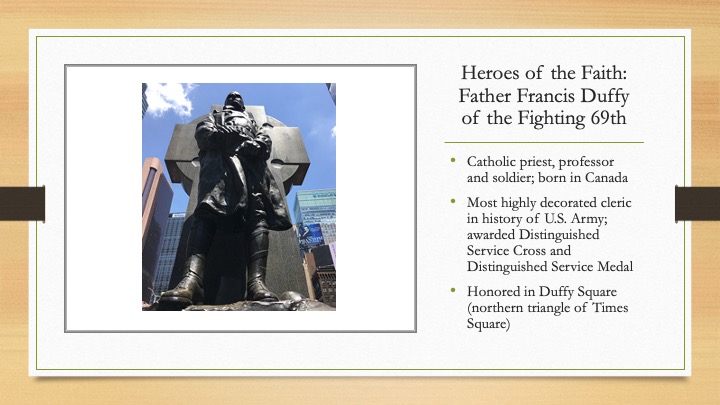
Heroes of the Faith: Father Francis Duffy of the Fighting 69th
Catholic priest, professor and soldier; born in Canada
Most highly decorated cleric in history of U.S. Army; awarded Distinguished Service Cross and Distinguished Service Medal
Honored in Duffy Square (northern triangle of Times Square)
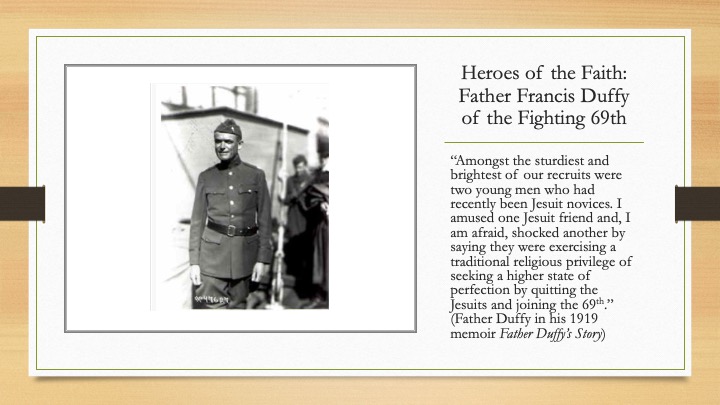
Heroes of the Faith: Father Francis Duffy of the Fighting 69th
“Amongst the sturdiest and brightest of our recruits were two young men who had recently been Jesuit novices. I amused one Jesuit friend and, I am afraid, shocked another by saying they were exercising a traditional religious privilege of seeking a higher state of perfection by quitting the Jesuits and joining the 69th.” (Father Duffy in his 1919 memoir Father Duffy’s Story)
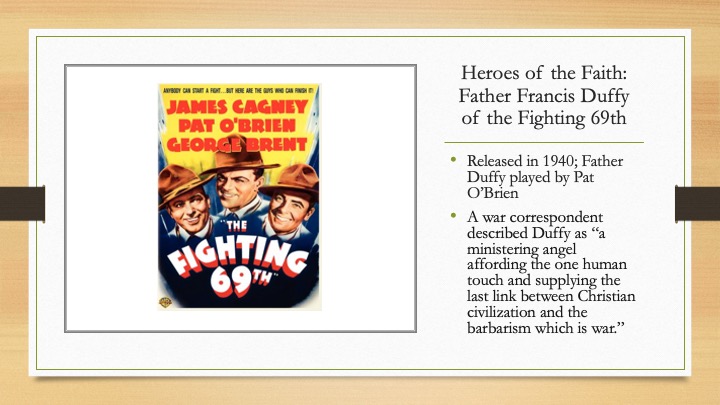
Heroes of the Faith: Father Francis Duffy of the Fighting 69th
Released in 1940; Father Duffy played by Pat O’Brien
A war correspondent described Duffy as “a ministering angel affording the one human touch and supplying the last link between Christian civilization and the barbarism which is war.”
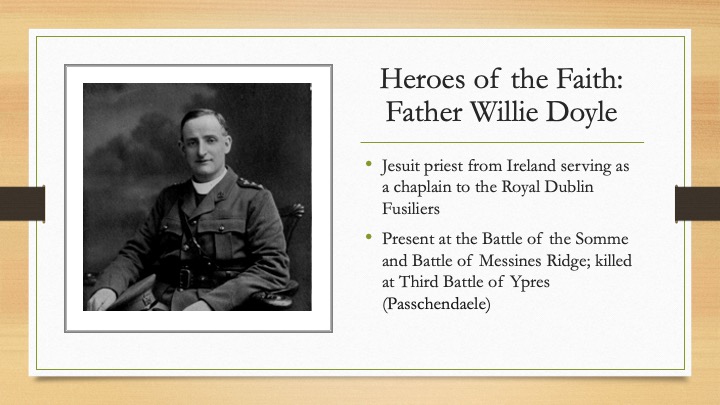
Heroes of the Faith: Father Willie Doyle
Jesuit priest from Ireland serving as a chaplain to the Royal Dublin Fusiliers
Present at the Battle of the Somme and Battle of Messines Ridge; killed at Third Battle of Ypres (Passchendaele)
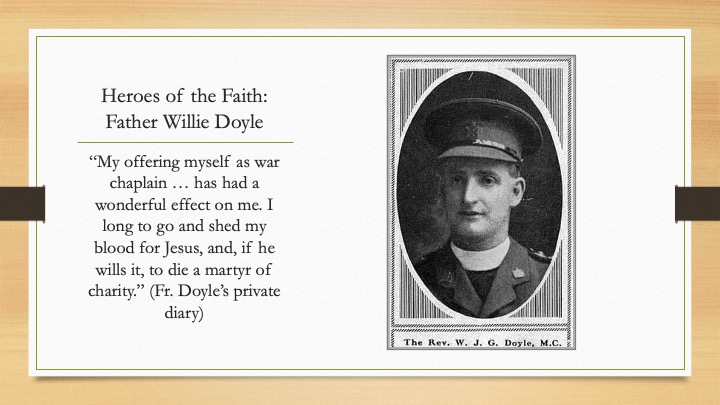
Heroes of the Faith: Father Willie Doyle
“My offering myself as war chaplain … has had a wonderful effect on me. I long to go and shed my blood for Jesus, and, if he wills it, to die a martyr of charity.” (Fr. Doyle’s private diary)
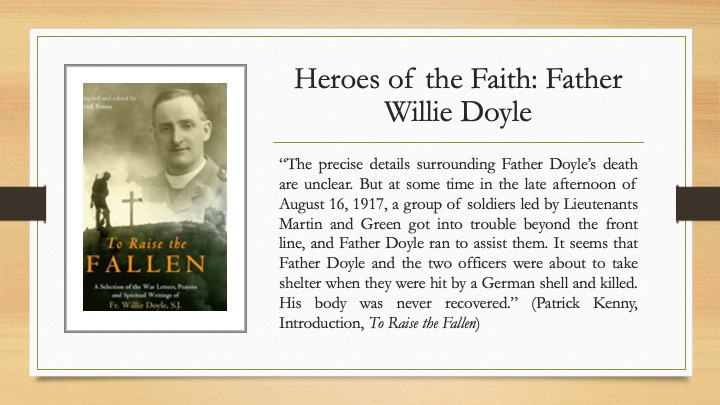
Heroes of the Faith: Father Willie Doyle
“The precise details surrounding Father Doyle’s death are unclear. But at some time in the late afternoon of August 16, 1917, a group of soldiers led by Lieutenants Martin and Green got into trouble beyond the front line, and Father Doyle ran to assist them. It seems that Father Doyle and the two officers were about to take shelter when they were hit by a German shell and killed. His body was never recovered.” (Patrick Kenny, Introduction, To Raise the Fallen)